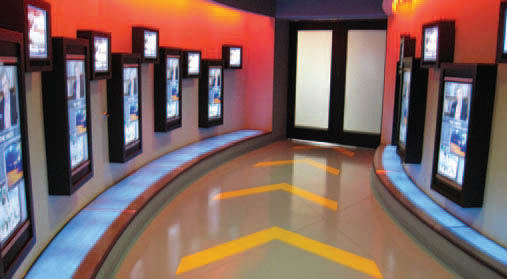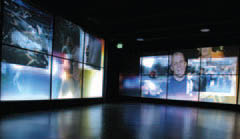AV Helps Explain the Unexplainable

- Electrosonic brings immersive exhibit experience to world's first museum about terrorism.
Explaining the history and evolution of terrorism is the intent of a new exhibit at The Center for Empowered Living and Learning (The CELL), a 6,000-square-foot facility that opened September 2, 2008 in Denver. "Anyone, Anytime, Anywhere: Understanding the Threat of Terrorism" is about the perpetrators, the victims, how world leaders view terrorism, and how different countries respond. According to executive
Ten Sharp 20-inch and nine Dell 37-inch LCD screens play synchronized videos documenting the evolution of terrorism and featuring interviews with experts from around the world. director Melanie Pearlman, it's the only museum of its kind in the world.
"The system integration started two years ago and the audiovisual content underwent many changes by virtue of the subject matter, and the care our founders took to get it right," says Pearlman. "We went through a number of production companies. Electrosonic was there throughout, and they helped in a couple of critical transitions as well."
To tackle the job, Electrosonic assembled a team from around the U.S. Electrosonic project manager Marcelo Videla says the team encountered several challenges along the way.
"Initially, there wasn't enough power, so we sourced equipment that kept power consumption down," he says. "And, counting computers, projectors, video players and other equipment, we have nearly 200 networked devices. We maxed out the telnet sessions on the AMX system, so we had to use two."
Visitors first enter a room themed "Faces of Terror." Three rear-projection screens show synchronized images of terrorists and their victims, projected by three NEC WT610 short-throw projectors to save space. (The NEC can project a 60-inch image from only 10.2 inches away.) Tannoy Di5 speakers were selected, says Videla, because they are small, easy to integrate, and produce good sound quality for their size.
Visitors then purchase their tickets, each of which is accompanied by a "Shattered Lives" magnetic card. The card is swiped at several kiosk stations positioned throughout the museum and, using custom Electrosonic software, the mag card readers progressively tell the story, and ultimately the fate, of an individual affected by terrorism.
A daily selection of features, industry news, and analysis for tech managers. Sign up below.
The first section of the exhibit, "Terrorism in our Times," uses 10 Sharp LC-20S7U 20-inch and nine Dell 37-inch LCD screens. Synchronized videos document the evolution of terrorism and play interviews with experts. A 24-track Fostex D2424LV hard disk recorder provides the sound.
Visitors proceed to "Terror Attacks Worldwide." Six 37-inch Dell LCD screens play attacks from around the world. Electrosonic also furnished High End Systems Technobeam lights that sweep the walls and floors with graphics and terrorism-related words and phrases.

Five Da-Lite rear projection screens and 30 NEC short-throw projectors create 360-degree seamless video at The CELL in Denver, CO. Denver in flames and the ensuing chaos. Electrosonic used five Da-Lite rear-projection screens divided by rear and front mullions. The result: 30 rectangular displays using 30 NEC WT610 projectors. Videla says there was no room behind the screens for regular lenses, so the short-throw projectors were ideal. Another Fostex 24-track player provides the audio here.
The next room features various AV interactives. Three Zytronic interactive touchtables let visitors explore terrorism's impact on civil liberties and homeland security. Visitors can also learn about terrorist activities and responses by country. A Panasonic PT-D3500U DLP projector displays imagery onto a mirror bounce above the touchtables, and a 37-inch Dell LCD monitor plays an attract loop.
Three 20-inch Sharp LCD screens play a video about how terrorists recruit youth, and a motion sensor triggers Dakota Audio FA-602- CM directional speakers.
Six 24-inch ELO touchscreens teach "The Future of Terrorism." "Terrorism and the Media," (how terrorists exploit the media) and "Voices of Reason/Voices of Hope" (world leaders discussing what can be done) are delivered using 65-inch Panasonic TH-65PF9UK plasmas and interactive stations using 23-inch LG LCDs. Each station also includes a joystick with left, right, and trigger controls. Here, visitors can select longer versions of video clips they have seen.
The finale is the "Action Room." Four touchscreen stations house the final magnetic card readers telling the fate of the person on their mag card. Visitors can also email the story to themselves and request information about supporting the museum.
To store and deliver content for The CELL, Electrosonic used 75 servers for close to 100 video displays. The original servers they chose could only upload video via Flash drives. "But the original content producer was based in England," says Videla. "So we changed to Adtec networked servers so they could change the video remotely."
The IT focus allows Electrosonic to remotely change the AV content. Videla says the company requests remote access for every project. "We can't always fly someone in fast enough for a repair, especially if a client is in another country." Remote network access is also critical for a timely subject such as exhibited at The CELL, where information is updated often, requiring functions such as timing and control to be adjusted.
The network also allows the onsite technician (an Electrosonic staffer assigned full-time to The CELL) to keep the nearly 200 devices operational with status reporting on the AMX control systems.
With such a long, complicated design and install, how did the client help facilitate the job? "They brought us in very early in the design phase," says Videla. "They aren't technical people and they have no technical staff, so it was very helpful to our work to be brought in during the concept design phase to figure out the technologies. Second, they basically trusted us and allowed us to give them the system they needed to get the job done."
